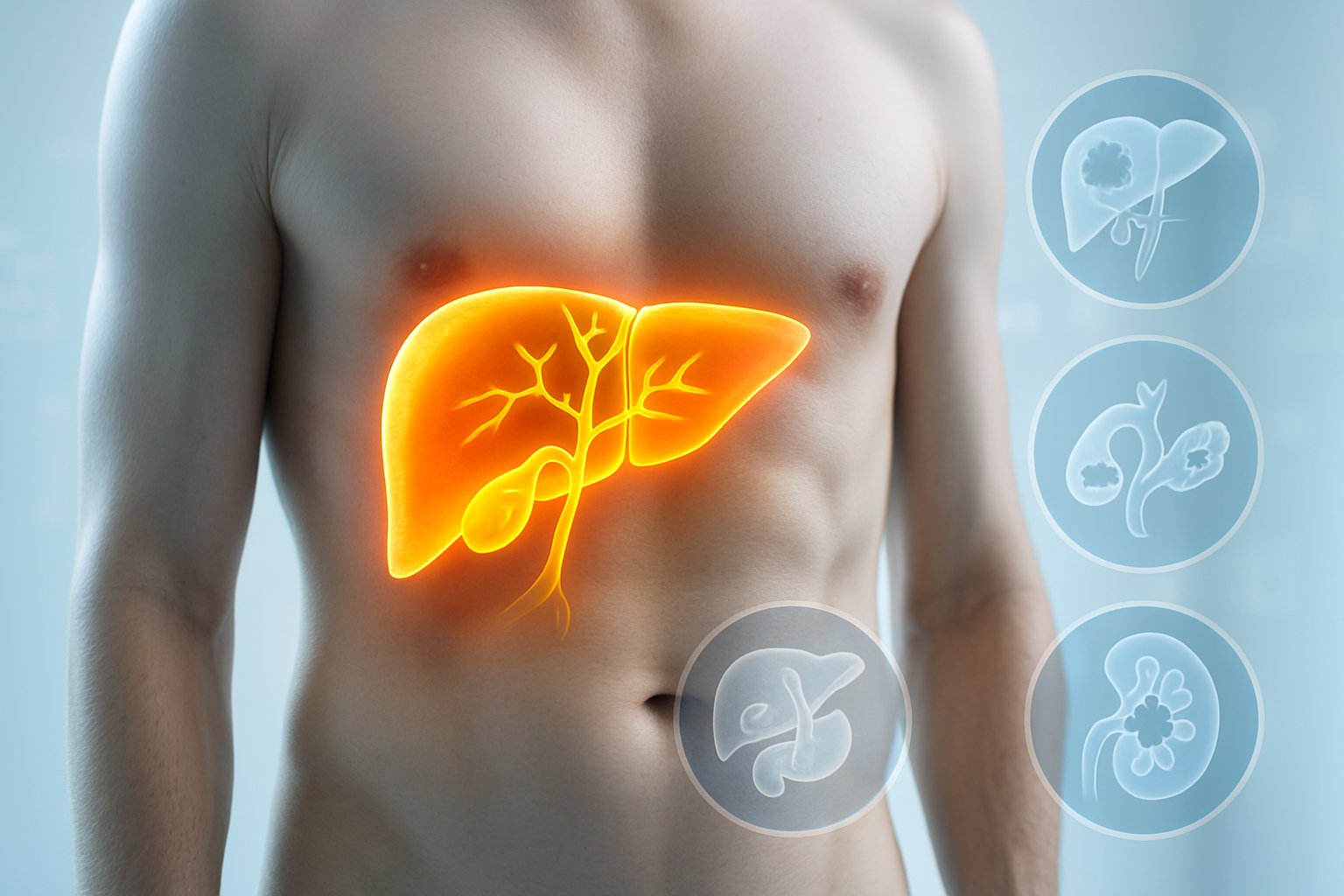Liver, pancreatic, bile duct, gallbladder, and certain blood cancers most commonly cause elevated bilirubin levels. Cancer increases bilirubin by blocking bile ducts or damaging liver cells that process this waste product. Patients with rising serum bilirubin should seek medical evaluation since both cancerous and non-cancerous conditions require treatment.
When yellow skin and eyes appear, many people wonder if cancer could be the cause. Several types of cancer can cause elevated bilirubin levels, including liver cancer, pancreatic cancer, bile duct cancer, gallbladder cancer, and lymphomas that affect blood cell breakdown. These cancers either block bile flow or damage the liver’s ability to process bilirubin properly.

Elevated serum bilirubin levels in cancer patients often signal that tumors are interfering with normal liver function or bile drainage. Gastrointestinal cancers pose the highest risk for hyperbilirubinemia because they can obstruct bile ducts or spread to the liver. Even small tumors in certain locations can cause significant increases in bilirubin levels.
Understanding which cancers affect bilirubin helps patients and doctors recognize warning signs early. While many non-cancerous conditions also cause elevated bilirubin[1], cancer patients with rising serum bilirubin levels need prompt evaluation to determine the underlying cause.
Types of Cancers Associated With Elevated Bilirubin

Several cancer types can raise bilirubin levels through different mechanisms. Liver and biliary tract cancers directly affect bile production, while pancreatic and ampullary tumors block bile flow.
Liver Cancer and Biliary Tract Cancers
Primary liver cancers like hepatocellular carcinoma directly damage liver cells that produce bile. This damage reduces the liver’s ability to process bilirubin normally.
Biliary tract cancers include tumors in the bile ducts, gallbladder, and surrounding areas. These cancers block bile flow from the liver to the small intestine.
Common biliary tract cancers that elevate bilirubin include:
- Cholangiocarcinoma (bile duct cancer)
- Gallbladder adenocarcinoma
- Perihilar cholangiocarcinoma
Serum bilirubin levels often rise significantly in these cancers. Patients typically develop jaundice as an early symptom.
The blockage prevents bile from leaving the liver properly. This causes bilirubin to back up into the bloodstream.
Pancreatic Cancer and Obstructive Jaundice
Pancreatic cancer commonly causes obstructive jaundice by blocking the common bile duct. The tumor grows near where the bile duct passes through the pancreas.
About 70% of pancreatic cancer patients develop elevated bilirubin levels. This happens because the tumor compresses the bile duct from the outside.
EUS (endoscopic ultrasound) helps doctors see pancreatic tumors that cause bile duct blockage. This test shows how the cancer affects bile flow.
Pancreatic adenocarcinoma in the head of the pancreas most commonly causes this problem. The sensitivity of bilirubin elevation for detecting pancreatic cancer is high when the tumor is in this location.
Bilirubin levels can rise very quickly in pancreatic cancer patients. This rapid increase often brings patients to medical attention.
Metastatic Cancers Affecting the Liver
Cancer that spreads to the liver from other parts of the body can raise bilirubin levels. These metastatic tumors take up space in the liver and block bile ducts.
Common cancers that spread to the liver include:
- Colorectal cancer
- Breast cancer
- Lung cancer
- Stomach cancer
The area under the curve (AUC) for bilirubin as a marker of liver metastases varies by cancer type. Multiple liver metastases cause higher bilirubin levels than single tumors.
These cancers damage normal liver tissue as they grow. They also can compress bile ducts within the liver itself.
Ampullary Adenocarcinoma
Ampullary adenocarcinoma develops at the ampulla of Vater, where bile and pancreatic ducts meet. This small but important area controls bile flow into the intestine.
Even small ampullary tumors can cause major bile duct blockage. The cancer blocks both bile and pancreatic juice from reaching the small intestine.
Patients with ampullary adenocarcinoma often have very high bilirubin levels early in the disease. The tumor’s location makes bile blockage almost inevitable.
This cancer type has a high sensitivity for causing jaundice compared to its small size. Doctors can often detect it early because of the obvious bilirubin elevation and jaundice symptoms.
Mechanisms and Risk Factors Linking Cancer and Elevated Bilirubin
Cancer can raise bilirubin levels through several pathways including tumor obstruction of bile ducts, increased breakdown of red blood cells, and interactions with genetic disorders. Cancer treatments also directly affect bilirubin metabolism in the body.
Hepatic and Biliary Obstruction by Tumors
Tumors can block bile ducts and prevent normal bilirubin flow. This causes serum total bilirubin to build up in the blood.
Pancreatic cancer often presses against the common bile duct. This blockage stops bile from reaching the intestines. Liver tumors can also compress bile ducts inside the liver.
Gallbladder cancer grows near important bile pathways. The tumor blocks bile flow early in the disease. Cholangiocarcinoma develops directly in the bile ducts themselves.
Primary blockage sites include:
- Common bile duct
- Intrahepatic bile ducts
- Hepatic ducts
- Gallbladder outlet
When bile cannot flow normally, both conjugated and unconjugated bilirubin rise. The liver still makes bile but cannot release it properly. This type of obstruction causes jaundice in many cancer patients.
Hemolysis in Cancer Patients
Some cancers destroy red blood cells faster than normal. This process releases more bilirubin into the blood.
Blood cancers like leukemia and lymphoma can cause hemolysis. The cancer cells attack healthy red blood cells. This creates extra unconjugated bilirubin that the liver must process.
Certain solid tumors also trigger red blood cell destruction. The cancer releases substances that damage blood cell membranes. Reactive oxygen species from tumors increase oxidative stress on red blood cells.
Factors that increase hemolysis in cancer:
- Tumor-produced toxins
- Immune system attacks on blood cells
- Oxidative stress from inflammation
- Low albumin levels
The bone marrow may not make enough new red blood cells to replace destroyed ones. This makes the hemolysis problem worse and keeps bilirubin levels high.
Genetic Disorders and Cancer Interactions
People with Gilbert’s syndrome have changes in the UGT1A1 gene. This gene controls how the liver processes unconjugated bilirubin.
Gilbert’s syndrome causes mild hyperbilirubinemia throughout life. These patients may have different cancer risks than people with normal bilirubin metabolism.
Cohort study data shows mixed results about cancer incidence in Gilbert’s syndrome patients. Some research suggests lower cancer rates due to bilirubin’s antioxidant effects. Other studies find no significant protection.
Genetic factors affecting bilirubin and cancer:
- UGT1A1 gene variants
- Family history of liver problems
- Inherited metabolic disorders
Body mass index and smoking status also influence how genetic disorders affect cancer risk. Machine learning models help researchers find patterns between genetic factors and cancer development. The hazard ratio for cancer varies based on bilirubin levels and genetic background.
Impact of Cancer Treatments on Bilirubin
Chemotherapy drugs can damage the liver and raise bilirubin levels. Many cancer medications are toxic to liver cells.
Radiation therapy near the liver or bile ducts causes inflammation. This swelling can block bile flow temporarily. Some patients develop permanent bile duct scarring.
Surgery to remove tumors may damage bile ducts accidentally. Liver surgery reduces the organ’s ability to process bilirubin. Recovery can take several weeks.
Common treatment effects:
- Liver cell damage from drugs
- Bile duct inflammation
- Surgical complications
- Medication interactions
Risk factors for treatment-related bilirubin problems include older age and existing liver disease. Patients with higher body mass index may process cancer drugs differently. Doctors monitor bilirubin levels closely during cancer treatment to prevent serious complications.
Frequently Asked Questions

Cancer patients and their families often have specific concerns about elevated bilirubin levels and their connection to different types of cancer. Understanding the warning signs, progression patterns, and management options helps patients make informed decisions about their care.
What indicators suggest a malignancy-related increase in bilirubin levels?
Jaundice without abdominal pain should be evaluated for cancer immediately[2], especially in patients over 50 years old. This combination raises the highest concern for pancreatic or bile duct cancers.
Yellow skin and whites of the eyes are the most obvious signs. Dark brown urine and light-colored or gray stools also indicate blocked bile ducts.
Patients may experience decreased appetite, unexplained weight loss, and fatigue. These symptoms can be vague but become more significant when combined with jaundice.
How do bilirubin levels correlate with liver cancer progression?
Bilirubin levels typically rise as liver cancer progresses and damages more liver tissue. The liver loses its ability to process bilirubin normally as cancer cells replace healthy liver cells.
Advanced liver cancer often causes severe jaundice because the liver cannot filter bilirubin from the blood. Higher bilirubin levels usually indicate more extensive liver damage.
Tumors that block bile ducts can cause rapid increases in bilirubin levels. This blockage prevents bile from flowing normally through the digestive system.
Can the presence of jaundice in a patient be an indication of a life-threatening cancer?
Yes, jaundice can signal life-threatening cancers like pancreatic cancer, liver cancer, or bile duct cancer. Most people with pancreatic cancer experience jaundice as an early symptom[2].
Pancreatic cancer is particularly dangerous because it often shows no other symptoms until it spreads. Jaundice may be the only early warning sign available.
Bile duct cancers and liver cancers also cause jaundice and can be life-threatening if not treated quickly. Early detection through jaundice evaluation can improve treatment outcomes.
Is jaundice a common prognosis factor for life expectancy in liver cancer patients?
Jaundice often indicates advanced liver cancer and can affect prognosis. Patients with jaundice typically have more extensive liver damage or bile duct blockages.
The timing of jaundice onset matters for prognosis. Patients who develop jaundice early in their cancer may have tumors in locations that block bile flow quickly.
Liver function tests and bilirubin levels help doctors assess how well the liver is working. Higher bilirubin levels often correlate with poorer liver function and may indicate shorter life expectancy.
What are the methods to manage and reduce bilirubin levels in patients with cancer?
Doctors can place stents in blocked bile ducts to restore normal bile flow. This procedure helps reduce bilirubin levels and relieves jaundice symptoms.
Surgical removal of tumors blocking bile ducts can restore normal bilirubin processing. This option works best when cancer has not spread extensively.
Chemotherapy and radiation therapy may shrink tumors that block bile ducts. These treatments can help restore bile flow and lower bilirubin levels.
How does colon cancer impact bilirubin levels in the body?
Colon cancer typically does not cause elevated bilirubin levels in its early stages. The colon is not directly involved in bilirubin processing or bile production.
Advanced colon cancer that spreads to the liver can cause elevated bilirubin levels. Liver metastases damage liver cells and interfere with normal bilirubin processing.
Large liver metastases from colon cancer may block bile ducts inside the liver. This blockage prevents normal bile flow and causes bilirubin to build up in the blood.
References
- What causes jaundice in adults?. https://www.mdanderson.org/cancerwise/what-causes-jaundice-in-adults.h00-159699912.html Accessed October 25, 2025
- Is jaundice a warning sign of cancer?. https://www.roswellpark.org/cancertalk/202502/jaundice-warning-sign-cancer Accessed October 25, 2025
